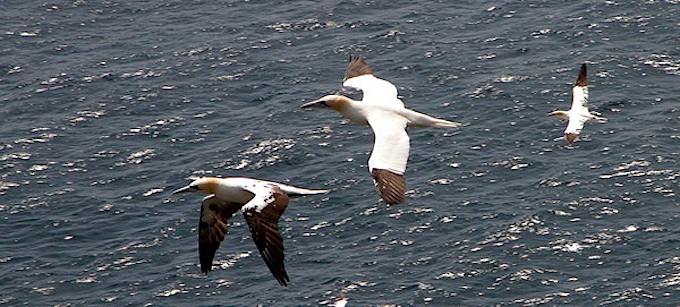I’m postponing the promised continued exploration of the birds of Newfoundland’s national parks to somewhat ironically discuss how many of those same birds are turning up all over the northeastern United States.
Hurricane Sandy was a huge storm and made landfall after crawling over the temperate waters of the North Atlantic where pelagic birds gather for the fall and winter. First, it must be said that no one is diminishing the tragic loss of life, property, and treasured belongings Sandy brought with it. I’ve never met a birder who would trade the sighting of an Atlantic Puffin in Michigan for the destruction of people’s lives and homes.
That said, once a storm passes, we birders tend to be overcome with curiosity about what the storm may have blown in. In the immediate hours after hurricane landfall, it’s typical to finds all sorts of seabirds up to several miles inland; and if birds could have confused looks on their faces, they definitely would. With larger storms, weakened birds can allow themselves to be carried by the winds far inland.
We reported here a few weeks ago the arrival of a soon-to-be deceased Great Shearwater on Lake Michigan, brought to us by Hurricane Isaac. Despite her horrid fury at the coast, Sandy was no less generous with seabirds in the Great Lakes region.
With the storm passing over colder waters than hurricanes typically do, the opportunity to see Alcids was what many birders had on their minds. Alcids, formerly known as Auks, are the family of birds including the charismatic Atlantic Puffin. These colonial nesters of rocky islands on the far northeast shore of North America, spend their winters somewhat farther south on the open water. That was the water Sandy churned on its way to landfall in North Jersey, coincidentally at Cape May, one of the most famous birding spots in the world.

Northern Gannets can be blown far off course by hurricanes. Kirby Adams photo.
Lakes Michigan and Huron last week both hosted at least one wayward Dovekie, a tiny Alcid that nests in the extreme north. Another Alcid, a Razorbill, was also reported from the region. A Northern Gannet, close relative of the Blue-footed Booby, turned up on Lake Michigan, while a Ross’s Gull caused a stir among birders in the Finger Lakes region of New York.
Alcids, gannets, gulls, and tubenoses were even more prevalent on the coast. The areas the northeast quadrant of the hurricane touch during landfall typically have the most birds. If you picture the counter-clockwise wind rotation of a low-pressure storm, you can see that this quadrant experiences direct winds from the ocean as it impacts an eastern coast. In this case, spots like Gateway National Recreation Area and Cape Cod National Seashore received the gift of many pelagic birds, but sadly the storm surge is also strongest in the same storm quadrant, and New York City bore the brunt of that surge that made the arrival of interesting birds utterly irrelevant to the human suffering.
But life goes on for many of us, and while I’ve been chasing Alcids on Lake Michigan, I’d love to hear about any other storm bird sightings. Has anyone been out at Gateway this week? If you see an interesting bird, be sure to report it. Data about storm-blown birds is valuable to ornithologists studying everything from migration to climate change. Let us know what you’ve spotted, but above all, stay safe!

 Support Essential Coverage of Essential Places
Support Essential Coverage of Essential Places






